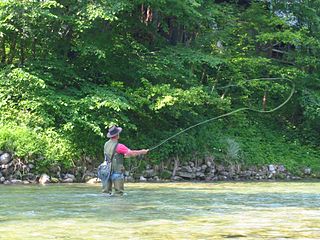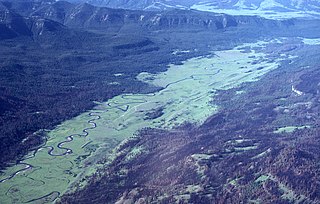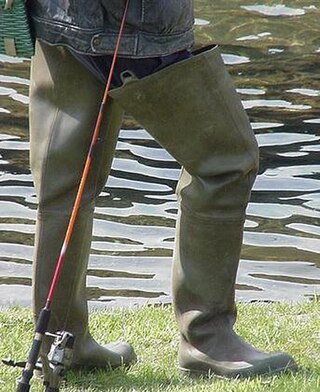
A boot is a type of footwear. Most boots mainly cover the foot and the ankle, while some also cover some part of the lower calf. Some boots extend up the leg, sometimes as far as the knee or even the hip. Most boots have a heel that is clearly distinguishable from the rest of the sole, even if the two are made of one piece. Traditionally made of leather or rubber, modern boots are made from a variety of materials.

A Wellington boot, often shortened to welly, and also known as a gumboot, rubber boot, or rain boot, is a type of waterproof boot made of rubber.

Fly fishing is an angling technique that uses an ultra-lightweight lure called an artificial fly, which typically mimics small invertebrates such as flying and aquatic insects to attract and catch fish. Because the mass of the fly lure is insufficient to overcome air resistance, it cannot be launched far using conventional gears and techniques, so specialized tackles are used instead and the casting techniques are significantly different from other forms of angling. It is also very common for the angler to wear waders, carry a hand net, and stand in the water when fishing.

Gore-Tex is W. L. Gore & Associates's trade name for waterproof, breathable fabric membrane. It was invented in 1969. Gore-Tex blocks liquid water while allowing water vapor to pass through and is designed to be a lightweight, waterproof fabric for all-weather use. It is composed of expanded PTFE (ePTFE), a stretched out form of the PFAS compound polytetrafluoroethylene (PTFE).

Slough Creek is a tributary of the Lamar River, approximately 25 mi (40 km) long, in Montana and Wyoming in the United States.

Combat or tactical boots are military boots designed to be worn by soldiers during combat or combat training, as opposed to during parades and other ceremonial duties. Modern combat boots are designed to provide a combination of grip, ankle stability, and foot protection suitable for a rugged environment. They are traditionally made of hardened and sometimes waterproofed leather. Today, many combat boots incorporate technologies originating in civilian hiking boots, such as Gore-Tex nylon side panels, which improve ventilation and comfort. They are also often specialized for certain climates and conditions, such as jungle boots, desert boots, and cold weather boots as well as specific uses, such as tanker boots and jump boots.
Early Winters, Ltd. of Seattle, Washington, United States was founded in 1972 by William S. Nicolai, who formed the company after creating a tent called the Omnipotent. Early Winters was the first company to create and sell a consumer product made with Gore-Tex laminates produced by W. L. Gore & Associates in Elkton, Maryland. The first product made with Gore-Tex fabric debuted in 1976 and was a streamlined, two-person tent called The Light Dimension. The tent was created by Nicolai and William H. Edwards and was marketed by Ron Zimmerman.

Hiking (walking) boots are footwear specifically designed for protecting the feet and ankles during outdoor walking activities such as hiking. They are one of the most important items of hiking gear since their quality and durability can determine a hiker's ability to walk long distances without injury. Hiking boots are constructed to provide comfort for walking considerable distances over rough terrain. Boots that protect the hiker's feet and heel are recommended. Hiking boots give ankle support and are fairly stiff. A less popular alternative is to use light trainers with thin soles. Footwear should be neither too loose nor too tight, to help prevent blisters and sore feet. Hiking socks that wick sweat from the feet, provide warmth, and cushion the feet are recommended and a thin, inner sock may also help. Most hiking boots are also designed for other outdoor activities such as backpacking, climbing, mountaineering, and hunting.
Berghaus Limited is a British outdoor clothing and equipment brand founded in Newcastle upon Tyne, North East England, and now headquartered in nearby Sunderland. It was founded in 1966 by climbers and mountaineers Peter Lockey and Gordon Davison, initially as an importer and distributor of outdoors products. Lockey and Davison's outdoor store in Newcastle upon Tyne, went by the name of the LD Mountain Centre. In 1972 they began designing and manufacturing their own products for sale in their shop. They gave their brand the German name 'Berghaus' which translates as 'mountain house'.

Arc'teryx is a Canadian apparel company specializing in outdoor apparel and equipment headquartered in North Vancouver, British Columbia. It focuses on technical apparel for mountaineering and Alpine sports, including related accessories. The company's name and logo reference the Archaeopteryx, the transitional fossil of early dinosaurs to modern dinosaurs (birds). Arc'teryx is known for its waterproof Gore-Tex shell jackets, knitwear, and down parkas.

W. L. Gore & Associates, Inc. is an American multinational manufacturing company specializing in products derived from fluoropolymers. It is a privately held corporation headquartered in Newark, Delaware. It is best known as the developer of waterproof, breathable Gore-Tex fabrics.

Waders denotes a waterproof boot or overalls extending from the foot to the thigh, the chest or even the neck. They are traditionally made from vulcanised rubber, but available in more modern PVC, neoprene and Gore-Tex variants. Waders are generally distinguished from counterpart waterproof boots by shaft height; the hip boot extending to the thigh and the Wellington boot to the knee. For the sake of emphasis, therefore, waders are sometimes defined by the extent of their coverage as thigh waders, chest waders or full-body waders. As a drysuit variant, full-body waders come with leaktight cuffs or gloves fitted to the sleeves and with a leaktight collar or hood fitted to the neck, enabling the wearer to remain dry when standing or walking in deeper water. Waders are available with boots attached or can have attached stocking feet, to wear inside boots, or inside swimfins in the case of float tube fishing.

The Extended Cold Weather Clothing System is a protective clothing system developed in the 1980s by the United States Army Natick Soldier Research, Development and Engineering Center, Natick, Massachusetts. The first generation ECWCS consisted of parka and trousers plus 20 other individual clothing, handwear, headwear and footwear items which are used in various combinations to meet the cold weather environmental requirements of the US military. The Extended Climate Warfighter Clothing System, or Gen III ECWCS, is designed to maintain adequate environmental protection in temperatures ranging between −60 and +40 °F.

Robert W. Gore was an American engineer and scientist, inventor and businessman. Gore led his family's company, W. L. Gore & Associates, in developing applications of polytetrafluoroethylene (PTFE) ranging from computer cables to medical equipment to the outer layer of space suits. His most significant breakthrough was likely the invention of Gore-Tex, a waterproof and breathable fabric popularly known for its use in sporting and outdoor gear.
Fly fishing tackle comprises the fishing tackle or equipment typically used by fly anglers. Fly fishing tackle includes:

Mountain Hardwear is a subsidiary of Columbia Sportswear based in Richmond, California that manufactures and distributes apparel, accessories and equipment primarily for the high performance needs of mountaineering enthusiasts and outdoor athletes, as well as for consumers who are inspired by the outdoor lifestyle.

Dan Bailey was a fly-shop owner, innovative fly developer and staunch Western conservationist. Born on a farm near Russellville, Kentucky, Bailey is best known for the fly shop he established in Livingston, Montana in 1938. Dan Bailey's Fly Shop is still in business.

Soda Butte Creek is an approximately 20 miles (32 km) long major tributary of the Lamar River in Yellowstone National Park. It is named for a now-extinct geyser near its mouth. Soda Butte and the creek were named by A. Bart Henderson, a Cooke City miner, in 1870. It rises just outside the northeast corner of the park on the southern slopes of the Absaroka Range near Cooke City, Montana. The Northeast East Entrance road parallels Soda Butte Creek for its entire length within the park. Soda Butte Creek is a popular angling destination for native Yellowstone cutthroat trout.
Vista Outdoor is an American designer, manufacturer, and marketer of outdoor sports and recreation products. It operates in two markets: shooting sports and outdoor products. It is a "house of brands" with more than 40 labels and subsidiaries. It trades under "VSTO" on the New York Stock Exchange.
Bud Lilly (1925-2017) was the owner of the Trout Shop in West Yellowstone, Montana as well as an accomplished baseball player, fly fishing guide, and conservationist.
















